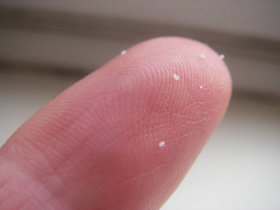It’s a little known fact that the majority of a flea infestation is comprised of eggs. One study found an infestation to have 50% eggs, 35% larvae, 10% pupae, and only 5% adults. So if you see 10 fleas hiding in the corner of your living room, there’s probably 50 or so eggs nearby. That’s a pretty shocking statistic that should serve as a real eye-opener to homeowners battling a severe flea infestation.
#1) Brush Your Pets With a Flea Comb
Pet owners should brush their dogs and cats with a flea comb on a daily basis. The fine teeth of the comb will catch both adults and eggs, allowing for a safe and effective means of eliminating these blood-sucking parasites. After making a pass through your pet’s fur, check the comb for any fleas or eggs. If you see any, drop them into a cup or bowl of soapy water, as this will drown them.
#2) Wash Your Pet’s Bedding
Another way to eliminate flea eggs from your carpet is to wash your pet’s bedding. A typical washing machine may reach temperatures of 140-160 degrees Fahrenheit, which is more than enough to kill both adult fleas and their eggs. With that said, it’s recommended that you wash your pet’s bedding in a separate load. Placing other garments inside the washing machine may result in the fleas infesting them as well.
#3) Vacuum and Sweet Your Floors
Even with all of the high-grade pesticides and chemicals available on the market, nothing beats a good old fashioned vacuum cleaner and broom. The truth is that flea eggs are often immune or resistant to pesticide chemicals. These chemicals may kill the adult fleas, but the eggs will remain protected. Vacuuming and sweeping, on the other hand, safely removed adults and their eggs.
#4) Lint Roller
Lint rollers serve a dual purpose; they can be used to remove flea eggs from the carpet, rugs, or practically any other surface. If you notice some flea eggs on your carpet, run a lint roller over them. In the event that you do not have a lint roller, you can use a strip of tape instead.
#5) Keep It Cool
No, this isn’t a typo. Maintaining a cool home will deter flea eggs from hatching. Studies have shown that fleas prefer temperatures of 70 degrees Fahrenheit or above. If your home is cooler than this amount, the eggs will remain dormant in an unhatched state, waiting until the conditions are right.

